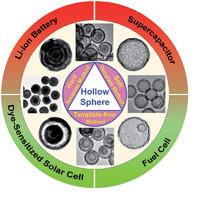It is clear that access to economically viable renewable energy sources is essential for the development of a globally sustainable society. There is a wide range of technologies — from solar cells to fuel cells and lithium-ion batteries— that can generate electricity without the use of fossil fuel. However, several defects, e.g. low efficiency, high cost or considerable environmental damage restrict their application range and development. The device efficiency strongly depends on the availability of novel functional materials for sustainable energy.
Hollow structures with multiple shells are expected to be an ideal material for energy conversion and storage due to their high surface-to-volume ratio and reduced transport lengths for both mass and charge transport. The research team lead by Prof. WANG Dan at Institute of Process Engineering, Chinese Academy of Sciences (IPE-CAS), has made a number of innovative achievements on hollow structures. Prof. Wang was invited to write a Perspective Article on Energy & Environmental Science about recent advances in micro-/nano-structured hollow spheres for energy applications (Energy Environ. Sci., 2012, 5, 5604-5618).
The vast array of synthetic methodologies used to create multi-shelled hollow structures has been summarized in the perspective article. Compared with conventional simple hollow structures, complex multi-shelled hollow spheres will be able to offer significant advantages by manipulating their structure on micro- and nano-scale, which will enlarge their promising applications for power generation and storage, including solar cells, fuel cells, lithium ion batteries and super capacitors. In addition, the emergent challenges and future developments of multi-shelled hollow structures have also been discussed.
This work was supported by the National Natural Science Foundation of China (No. 21031005, 20971125, 21006116, 91122014, 51172235 and 21050110428), Beijing Municipal Natural Science Foundation (No. 2082022), and the Foundation for State Key Laboratory of Multi-phase Complex Systems (No. MPCS-2011-D-15) and National Key Laboratory of Biochemical Engineering (No. 2010KF-09).

Illustration of thesynthetic methodologies for the hollow sphere and their promising applications